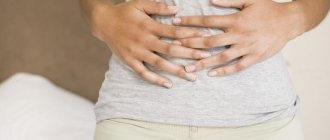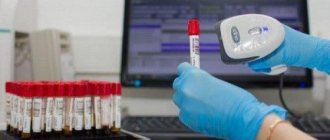Diarrhea
(scientific name
diarrhea
) is a pathological condition in which frequent bowel movements are observed, and the stool becomes liquefied (from mushy to watery). The stool may contain particles of mucus, pus, undigested food and even blood, have a pungent odor and an unusual color.
In a newborn baby who is breastfed, the frequency of bowel movements on average corresponds to the number of feedings (up to 6 times a day). Gradually, the frequency of stool decreases and by 6 months it stabilizes at the level of one or two times a day. Similar regularity in bowel function is typical for an adult. Deviations in one direction or another can be considered as bowel disorders.
Prolonged or severe diarrhea is dangerous to health, as it threatens dehydration.
Causes of diarrhea
Diarrhea is a symptom of many diseases and pathological conditions of the gastrointestinal tract (GIT).
The most common cause of diarrhea is viral infections (rotaviruses, noroviruses, adenoviruses and others) or bacterial infections such as dysentery, salmonellosis and others.
But diarrhea can also develop under the influence of medications, for example, antibiotics and antiarrhythmic drugs. It may be the result of individual intolerance to a particular food product, the so-called food allergy. Diarrhea can be caused by errors in diet or abuse of fatty, heavy foods. It accompanies a number of chronic gastrointestinal diseases (gastritis, pancreatitis, ulcers) or is a manifestation of irritable bowel syndrome.
But it is important to know that if we are talking about adults, then most often their diarrhea is a consequence of poisoning with spoiled or low-quality products, the so-called foodborne toxic infection. Typically, food poisoning has a clear clinical picture: in addition to frequent loose stools, there is vomiting, weakness, and fever with high body temperature. It develops rapidly and lasts from 1 to 3 days.
Often, diarrhea in adults occurs during travel, especially if it is a trip to exotic countries. There is even a special term - traveler's diarrhea; up to 30% of all tourists visiting exotic countries suffer from it. Intestinal upset in this case is associated with changes in climatic conditions, adaptation to new water, food, spices, stress due to flight or lowered hygiene standards in a number of countries.
Diarrhea due to diseases of the digestive system
In the practice of a gastroenterologist, diarrhea is one of the most common symptoms, which can be a sign of many different pathological conditions. From the point of view of existing diagnostic criteria, diarrhea is a pathological condition that implies a change in both the shape of feces and the frequency of bowel movements. First of all, this is an increase in bowel movements (more than 3 times per day), in addition, the release of liquid feces (watery or mushy) with a volume of more than 200 ml.
There are acute and chronic diarrhea. Symptoms of acute diarrhea can last from a few days to 4 weeks. In most cases, episodes of acute diarrhea are associated with viral, bacterial or parasitic infestations. In chronic diarrhea, symptoms persist for more than 4 weeks.
Diseases of the digestive system are usually accompanied by chronic diarrhea. These include: atrophic gastritis with reduced secretory function of the stomach, postgastroresection and postvagotomy disorders, chronic pancreatitis with exocrine pancreatic insufficiency, biliary dysfunction and postcholecystectomy syndrome, chronic liver diseases, pathology of the small intestine, accompanied by the development of malabsorption syndrome, bacterial contamination of the small intestine, ulcerative colitis and Crohn's disease, tumors of the small and large intestine, ischemic and pseudomembranous colitis, functional bowel diseases, hormonally active tumors of the gastrointestinal tract (GIT).
There are four pathogenetic variants of diarrhea.
- Secretory diarrhea This type of diarrhea is characterized by frequent loose stools of more than 1000 ml per day. It occurs primarily in bacterial and viral infections (cholera, salmonellosis, rotavirus and HIV infections), as well as in hormonally active tumors - apudoms (gastrinoma, VIPoma, carcinoid).
- Osmotic diarrhea The volume of liquid feces ranges from 500 to 1000 ml per day. Osmotic diarrhea occurs in chronic pancreatitis with exocrine insufficiency, fermentopathy, celiac enteropathy, Whipple's disease, dumping syndrome, bacterial contamination of the small intestine, and the use of osmotic laxatives.
- Exudative diarrhea The volume of liquid feces is 200–500 ml per day. This type of diarrhea develops with ulcerative colitis, Crohn's disease, ischemic and pseudomembranous colitis, colon tumors, radiation colitis, dysbiosis, colon diverticulosis with diverticulitis.
- Motor diarrhea As a rule, with this form of diarrhea, polyfecal matter is not observed: the volume of liquid feces per day is no more than 200–300 ml. Motor diarrhea is typical of irritable bowel syndrome (IBS), functional diarrhea, intestinal dysbiosis, and is observed in patients after vagotomy.
Quite often, chronic diarrhea is a clinical sign of malabsorption syndrome. This term has been widely used in foreign literature for many years. Malabsorption syndrome is characterized by a disorder of absorption of nutrients in the small intestine and a disorder of metabolic processes. The development of this syndrome is based not only on morphological changes in the mucous membrane of the small intestine, but also on disturbances in the enzyme systems of the gastrointestinal tract, intestinal motor function, as well as disorders of specific transport mechanisms.
In domestic clinical practice, the term “chronic enteritis” is more often used. However, histological examination does not reveal chronic inflammation in the majority of such patients.
Malabsorption syndrome can be caused by damage to any of the layers of the wall of the small intestine. Absorption disorders can be partial (the absorption of individual nutrients is difficult) or general (the absorption of all products of food digestion is difficult).
There are primary and secondary malabsorption. Primary malabsorption is based on enzymopathies, hereditary changes in the structure of the absorptive epithelium (celiac disease, disaccharide intolerance, collagen sprue, tropical sprue).
Secondary malabsorption is caused by damage to various layers of the wall of the small intestine, as well as other organs (Whipple's disease, Crohn's disease, chronic enteritis, intestinal resection, pancreatic pathology, gastric resection, poisoning, radiation damage, amyloidosis, infectious and viral diseases, immunodeficiency states).
Let us recall the functional morphology of the small intestine. It consists of four membranes: mucous, submucosal, muscular and serous.
The mucous membrane forms spiral or circular folds, due to which the absorption surface increases by 2–3 times. In addition, the circular arrangement of the folds promotes mixing of the chyme and its retention in the resulting niches. There are many villi located on the surface of the mucosa. They are represented by protrusions of the lamina propria, covered with columnar epithelium, goblet cells, single-layer bordered epithelium, 90% of which are enterocytes with a brush PIC-positive border formed by microvilli. On the surface of each enterocyte there are 1500–2000 microvilli, which increase the absorption surface of the intestine by 30–40 times (up to 200 m2). The brush border is characterized by high alkaline phosphatase activity. Goblet cells are located among the bordered epithelium.
At the base of the crypts there are single cells with large eosinophilic granules. These are Paneth cells, which resemble pancreatic acinar cells. There is evidence that Paneth cells must compensate for the impaired exocrine function of the pancreas (contain trypsin, phospholipase, trypsin inhibitor). In addition, Paneth cells contain lysozyme, immunoglobulin A, i.e. perform a bactericidal function.
The epithelial cells covering the areas of the intestine occupied by Peyer's patches differ in structure and function; they are called membranous cells (M cells). There are few microvilli on them, and enzyme activity is lower. M cells capture and transport antigens from the intestinal lumen to the lymphoid tissue. In addition, there are many endocrine cells in the small intestine.
Metabolic disorders in malabsorption syndrome include metabolic disorders: protein (loss of body weight, hypoproteinemia, hypoalbuminemia, edematous-ascitic syndrome, imbalance of amino acid concentrations in the blood serum, increased loss of protein in feces - creatorrhoea), carbohydrate (impaired hydrolysis and absorption of carbohydrates, hypoglycemia, flat glycemic curves, excessive formation of organic acids in the intestines) and lipid (weight loss, decreased lipid levels in the blood, steatorrhea due to the increased content of fatty acids and soaps in the feces). The absorption of Ca++, Mg++ and vitamin D is closely related to the absorption of fats. A decrease in the absorption of Ca++ and Mg++ is due to the formation of insoluble calcium and magnesium soaps through the interaction of these salts with fatty acids not absorbed in the intestine. Vitamin D deficiency can be explained by its dissolution in unabsorbed fats.
With malabsorption, symptoms associated with a deficiency of electrolytes, microelements, and vitamins are observed. Pluriglandular insufficiency may develop (pituitary-adrenal, sexual disorders, decreased thyroid function). On the contrary, functional intestinal diseases are never accompanied by metabolic disorders, and the patient’s general condition does not suffer. However, making a diagnosis of a functional disorder (IBS, functional diarrhea) is always a very responsible and serious task, requiring the exclusion of organic intestinal pathology, infectious and helminthic diseases. In the differential diagnosis, the so-called “alarm symptoms” (weight loss, fever, blood in the stool, anemia, family history of colon cancer, antibiotic treatment) should be excluded. There are diagnostic criteria that allow you to differentiate between IBS and organic gastrointestinal diseases:
- short medical history (less than 2 years);
- persistent diarrhea;
- diarrhea at night;
- acute onset of diarrhea;
- loss of body weight (5 kg or more);
- accelerated erythrocyte sedimentation rate;
- low blood hemoglobin level;
- low blood albumin level;
- positive test for laxatives in urine;
- polyfecal;
- pathology found in intestinal biopsy;
- pathology detected during sigmoidoscopy.
Modern diagnosis of digestive diseases associated with diarrhea is quite complex and includes, in addition to clinical ones, a large list of laboratory and instrumental methods.
First of all, this is a general clinical analysis of blood and urine, scatological examination, biochemical blood test (total protein and protein fractions, glucose, blood lipids, electrolytes, serum iron, liver tests, pancreatic enzymes), ECG, microbiological examination of stool to exclude the infectious origin of diarrhea, determination of elastase-1 in feces. To assess the acid-producing function of the stomach, pH measurements are performed. X-ray examination includes examination of the stomach and passage of barium through the small intestine, and, if necessary, irrigoscopy.
The diagnostic standard for diarrhea also includes ultrasound of the digestive organs (liver, biliary tract, pancreas, intestines). In case of chronic diarrhea, esophagogastroduodenoscopy is performed with a biopsy from the descending duodenum or proximal jejunum for histological examination, qualitative determination of lactase enzyme activity in the biopsy specimen, bacteriological examination (to diagnose bacterial contamination of the small intestine); to exclude pathology of the large intestine - colonoscopy with examination of the terminal part of the small intestine. In recent years, video capsule studies have been used to assess the condition of the intestine (especially the small intestine).
A hydrogen breath test using gas analyzers allows you to determine excessive bacterial growth (bacterial contamination) in the small intestine, fermentopathy, and motor function of the small intestine.
Currently, a respiratory carbon test with the C13 isotope has appeared to assess the functional state of hepatocytes, exocrine function of the pancreas, identify enzymopathies, bacterial contamination of the small intestine and motor function of the gastrointestinal tract. In difficult diagnostic cases, to exclude immunodeficiency conditions, the patient’s immune status is assessed (the main subpopulations of immunocompetent cells, immunoglobulins in the blood serum). To assess local immunity, acute-phase proteins, albumin, α-1-antitrypsin, and secretory immunoglobulin A are determined in the perfusate of the small intestine. The standard method recommended by WHO for assessing the permeability of the intestinal barrier is the enzyme-linked immunosorbent method with a chicken egg ovalbumin load.
In the diagnosis of celiac enteropathy, in addition to histological examination of a biopsy of the small intestinal mucosa, it is necessary to determine antibodies to gliadin, tissue transglutaminase and determination of antiendomysial antibodies in the blood serum.
In addition to X-ray examination, assessment of intestinal motor function can also be carried out using the radionuclide method after breakfast with a Tc99 radiolabel (scintigraphy of the stomach, small and large intestine).
Treatment of chronic diarrhea syndrome in diseases of the digestive system should be comprehensive, ensuring the normalization of the patient’s nutritional (trophological) status and the development of adaptation-compensatory processes, which helps improve the quality of life.
The first and leading should be the prescription of diet therapy . Nutritional therapy for diarrhea includes the administration of a standard diet, and, if necessary, elimination diets and enteral nutrition mixtures.
The standard diet option is characterized by a high protein content (110–120 g), physiological norms of fat (90 g) and carbohydrates (300–350 g), vitamins and minerals in the daily diet. The energy value is 2500–2600 kcal. Culinary processing of products is provided, allowing for maximum sparing of the mucous membrane of the small intestine and slowing down the passage of food. Meals are fractional, foods with coarse fiber, milk, canned food, spicy and salty foods, and alcoholic drinks are excluded.
Elimination diets involve excluding milk for lactase deficiency, prescribing a gluten-free diet and excluding products containing “hidden” gluten (canned food, sausages, kvass, gin, products with gluten-containing stabilizers) for celiac enteropathy.
Prescribing enteral nutrition mixtures to patients with clinical manifestations of malabsorption syndrome and underweight is necessary in all cases where a standard diet fails to provide nutritional support. Standard, semi-elemental, modular, immunomodulatory and special metabolic mixtures are used to correct metabolic disorders, as an alternative to drugs (Nutrizon, Clinutren, Berlamin Modular, Unipit, Peptamen, etc.).
To correct metabolic disorders, in some cases , replacement therapy is used, including acids, iron preparations.
, broad are prescribed 5–7 days. To suppress the growth of anaerobic bacteria, use metronidazole 0.5 g 3 times a day for 7–10 days. Intestinal antiseptics with a wide spectrum of action are effective: Intetrix 1 capsule 3 times a day - 7-10 days, Ersefuril 200 mg 4 times a day - 7 days.
In addition, drugs with a probiotic effect are currently used to decontaminate the small intestine: Enterol 1 capsule 2 times a day for 14 days, Baktisubtil 1 capsule 2-3 times a day for 3-4 weeks, as well as drugs based on Bacillus subtilis (Sporobacterin, Biosporin, Bactisporin).
After antibacterial therapy, the use of prebiotics (Hilak forte - 40-60 drops 3 times a day for 2-4 weeks; Duphalac in a prebiotic dose of 5-10 ml per day for 1 month) is effective to restore normal intestinal microflora. For the same purpose, probiotic drugs are prescribed (Linex, Bifidumbacterin forte, Probifor, Bifiform, Acylact, Colibacterin in medium therapeutic doses for at least 4 weeks), as well as synbiotic biocomplexes (Normoflorin L, Normoflorin B, Normoflorin D) in courses of 2– 4 weeks
One of the probiotics widely used in clinical practice is Linex, a combination drug that contains three types of bacteria: Bifidobacterium infantis v. liberorum, Lactobacillus acidophilus and non-toxigenic lactic acid group D streptococcus Streptococcus faecium. Linex meets modern requirements: it contains a complex of living microorganisms that play an important role in maintaining the intestinal biocenosis; all three strains of Linex bacteria are resistant to the aggressive environment of the stomach, which allows them to easily reach all parts of the intestine without losing their biological activity. The use of Linex is safe in any age group of patients. The microbial components of Linex are highly resistant, which makes it possible to take the drug simultaneously with antibiotics and chemotherapeutic agents. Adults and children over 12 years of age are prescribed 2 capsules 3 times a day after meals. The course of treatment depends on the causes of dysbiotic disorders. There are no cases of side effects or overdose of Linex in the literature.
In the treatment of antibiotic-associated diarrhea and pseudomembranous colitis, the drugs of choice are vancomycin, metronidazole, Enterol. Patients with Whipple's disease are prescribed tetracycline at a dose of 1-2 g per day, Biseptol - 6 mg/kg body weight for 5-9 months, followed by a dose reduction.
Intestinal motility and secretion inhibitors are prescribed
Since ancient times, doctors have used opium tincture for diarrhea syndrome. Currently, loperamide (Imodium) is prescribed to reduce the frequency of stools and hypersecretion of mucus in the intestines - 1-2 capsules 1-4 times a day until normal stools appear or the absence of bowel movements for more than 12 hours. Along with loperamide, platiphylline is classified as a regulator of intestinal motility , hyoscine butyl bromide (Buscopan), drotaverine (No-shpa), which are prescribed 40–80 mg 3 times a day, Meteospasmil (1–2 capsules 3 times a day). In case of hormonally active tumors, analogues of the hormone somatostatin (Octreotide, Sandostatin) have a good antidiarrheal effect.
Astringents and enveloping agents absorb These include preparations containing white clay, tannin, bismuth; Neointestopan, Tannacomp (which has an astringent, enveloping and antibacterial effect), Almagel, Smecta, which are prescribed for 5–7 days.
In clinical practice, medicinal plants are also used for this purpose: blueberries, bird cherry, St. John's wort, oak bark, alder cones, pomegranate peel in the form of decoctions.
Enterosorbents prevent These include Smecta, Enterosgel, Polyphepan, Filtrum-STI, Neointestopan, which are prescribed on average for 10–14 days, in the intervals between meals. Cholestyramine and Bilignin are effective for cholegenic diarrhea.
Enzyme preparations are prescribed For lactase deficiency in children, the enzyme Lactase Baby is used (1 capsule with each feeding of a child under 1 year of age; for children under 7 years old - 2-5 capsules with food containing milk). An elimination diet (with the exception of milk) is recommended for adult patients. When choosing enzyme preparations containing pancreatin, it is necessary to give preference to products characterized by a high content of lipase, and also pay attention to the release form (minimicrospheres resistant to the action of gastric juice) (Creon, Pancitrate). The daily dose of enzyme preparations in the treatment of malabsorption syndrome should be 30,000–150,000 units (in terms of lipase content).
Glucocorticosteroid drugs are used
Thus, diarrhea can be a symptom of many digestive diseases. Adequate diagnostic measures for diarrheal syndrome allow the doctor to prescribe optimal complex, etiotropic and pathogenetic treatment.
Literature
- Eremina E. Yu., Tkachenko E. I. Diagnosis and treatment of the main syndromes of intestinal damage. Saransk, 2006. 151 p.
- Parfenov A.I. Enterology. M.: Triada-X, 2002. 744 p.
- Khoroshilov I. E. Enteral nutrition in gastroenterology: yesterday, today, tomorrow // Farmateka. 2005. No. 14. pp. 32–36.
- Sheptulin A. A. Malabsorption syndrome: clinical picture, diagnosis and treatment // Consilium medicum. 2001. T. 3. No. 6. P. 267–269.
- Brown KH Diarrhea and malnutrition // J. Nutr. 2003; Jan, 133(1): 328–332.
- Camillery M. Chronic diarrhea: a review on pathophysiology and management for the clinical gastroenterologist // Clin Gastroenterol Hepatol. 2004; Mar 2(3): 198–206.
- Schiller IR Nutrition management of chronic diarrhea and malabsorption // Nutr.Clin. Pract. 2006; Feb 21(1): 34–39.
I. D. Loranskaya, Doctor
Why is diarrhea dangerous for adults?
Acute diarrhea in adults is dangerous because it can become chronic. In this case, loose stool haunts a person every day for a month or more. This significantly affects a person’s overall well-being, performance, immunity and, of course, quality of life. In this case, you need to consult a doctor and undergo a comprehensive examination and treatment. Find out the cause of diarrhea and eliminate it!
Diarrhea is also dangerous due to the development of complications such as: - Dehydration. - Heart rhythm disturbances, convulsions, muscle pain. — Cachexia is a state of extreme exhaustion of the body.
How does water absorption occur in the intestine?
Every day a person consumes approximately 2 liters of water. It is found not only in drinks, but also in all foods eaten. In addition, liquid enters the lumen of the digestive tract as part of digestive secretions. And about 7 liters are released per day! This includes 1.5 liters of saliva and pancreatic juice, 2.5 liters of gastric juice, half a liter of bile and a liter of intestinal secretions. In total, up to 9 liters of water enter the intestinal lumen daily, and only 100–200 ml (that is, about 2%) of this volume is excreted in the feces. The walls of the small intestine absorb up to 80% of all fluid, and 90% of the remaining amount is absorbed in the large intestine.
In this case, water is absorbed secondarily and passively, following the active transport of electrolytes through the walls of the digestive tract. Sodium ions play the most important role in this process, but potassium and chlorine also take an active part. All these electrolytes enter the intestines with food and digestive juices and are actively absorbed. In this case, the final absorption of water and the absorption of up to 90% of sodium occurs in the large intestine. As a result, fairly dense feces are normally formed here.
Bacterial infections
The causative agents of bacterial diarrhea of the invasive and secretory type are single-celled microorganisms (Salmonella, Shigella, Clostridia and others). They are able to multiply on the surface and in the deeper layers of the intestinal wall, and also penetrate into the blood, causing the development of bacteremia. So-called foodborne illnesses, the development of which is caused by various types of opportunistic microorganisms that can produce toxins in food, can also cause bacterial diarrhea. The trigger mechanism of the disease is inflammation of the small or large intestine.
Symptoms
Bacterial diarrhea occurs with severe symptoms of acute intoxication:
- significant deterioration in health,
- headaches,
- nausea,
- vomiting,
- an increase in body temperature to +38…+39 °C.
Infections caused by bacteria, leading to accelerated peristalsis and rapid evacuation of intestinal contents, are accompanied by painful tenesmus (painful false urge to defecate), spastic pain in the abdomen, and the development of fermentative dyspepsia (a pathological condition in which the human intestine produces alcohol and carbon dioxide, which are formed due to the breakdown of carbohydrate foods). Pathological impurities (mucus, blood, particles of pus) are present in the stool. Toxic waste products of microorganisms, absorbed through the intestinal walls into the blood, cause the development of severe syndromes of infectious endotoxicosis and become the main cause of dehydration.
Diarrhea due to infectious diseases of a bacterial nature in some cases may be accompanied by meningeal symptoms or severe muscle and osteoarticular pain.
Diagnosis of bacterial intestinal infections
To identify the true cause of the disease, doctors usually prescribe laboratory testsiii aimed at detecting the pathogen in feces and vomit, gastric lavage and food debris, presumably the source of infection. If the development of salmonellosis is suspected, a bacteriological blood test (blood culture) is performed in parallel. In the absence of growth of pathogenic bacterial microflora, virological studies are additionally carried out to clarify the etiology of viral diarrhea.
Treatment of bacterial diarrhea
Treatment of infectious diarrhea of bacterial origin is prescribed by a doctor. It is usually carried out in a complex that includes therapeutic nutrition, pathogenetic, etiotropic and symptomatic therapy. Pathogenetic therapy drugs include rehydrants (medicines to restore fluid and electrolyte balance), enterosorbents (drugs that have the ability to bind and remove bacteria and microbial toxins from the body), enzymes, probiotics (bifidobacteria and lactobacilli). Etiotropic drugs (antibiotics) are prescribed strictly according to medical indications, taking into account the sensitivity of the pathogen. Antispasmodic, antinausea, antiemetic and antidiarrheal drugs are used as symptomatic treatment drugs aimed at eliminating individual symptoms of infectious diarrhea.
To normalize intestinal function, reduce the frequency of the urge to defecate and better retain feces, experts can recommend IMODIUM® Express. Easily adsorbed from the gastrointestinal tract, the antidiarrheal drug, intended for adults and children over 6 years of age, helps to reduce or completely eliminate negative intestinal symptoms.
In the case of a clinically pronounced course of the disease, the patient is hospitalized.
Up to contents
What happens during a doctor's examination
The outcome of treatment for secretory diarrhea depends on the correct diagnosis. Diagnostics is as follows:
- Questioning the patient - the presence and nature of complaints, duration of diarrhea
- Examination of the patient - special attention should be paid to the degree of dehydration and symptoms of hypokalemia - convulsions, muscle roll syndrome
- Proctological examination - this will reveal tumor processes, fissures or fistulas of the anus
- Study of stool tests - coprogram, parasite eggs, stool occult blood test, bacterial culture
After the research and diagnosis, the doctor decides whether to hospitalize the patient. With secretory diarrhea, no signs of severe intestinal infection, or mild dehydration, adult patients can be treated at home. In all other cases, including pregnant women, treatment in a hospital setting is indicated.








